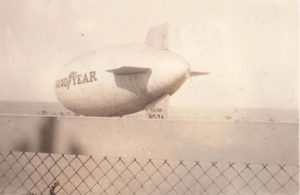by Jack El-Hai (Wonders & Marvels contributor)
For a certain group of enthusiasts — of whom I am one — these are the weeks that bring hope at the end of the long, cold winter. Down south, in states climatologically blessed, uniformed players are throwing balls, swinging bats, and loosening muscles. Of all the visions that most strongly signal the return of baseball, my favorite is the sight of a catcher hurling away his facemask to circle under a high pop fly and make the catch.
But the catcher does not always make the catch. Or the falling ball does not always behave as we expect it to. What happened to catcher Joe Sprinz when he tried to catch a plummeting ball in 1939 is unparalleled in baseball lore.
A publicity stunt
Sprinz, whose best years were by then behind him, had seen major league action as a career .170 hitter between 1930 and 1933 with the St. Louis Cardinals and the Cleveland ballclub. In 1939, the veteran was on the way down, playing in the Pacific Coast League with the minor-league San Francisco Seals.
To mark the centennial of the invention of baseball and the celebration of Baseball Day at the Golden Gate Exposition, the Seals came up with a publicity stunt. On August 3 they floated a Goodyear blimp 800 feet over Seals Stadium, from which blimp captain A. J. Sewell would drop some baseballs. It was Sprinz’s job to stand beneath, glove in hand, to wait for these tiniest of white specks to enlarge into balls falling at a ferocious speed, and to make the catch. If he succeeded, he would set a new record for catching a baseball dropped from the greatest height.
This wasn’t a completely original idea. Just three months earlier, Philadelphia Phillies catcher Dave Coble had caught a ball dropped 521 feet from the tower of Philadelphia’s city hall. Other ballplayers had attempted similar stunts.
Falling at 170 MPH
But the attempt in San Francisco was the most ambitious. The first four balls dropped from the blimp over Seals Stadium fell far from Sprinz. He had a chance to catch the fifth, though. He settled under it, and the ball shot into his mitt. The ball was moving at something like 170 miles per hour, however — a velocity with which Sprinz had no previous experience. The ball and mitt crushed the ballplayer’s face, injuring his nose, causing a compound jaw fracture, smashing eight teeth, and cutting both lips. The impact also knocked Sprinz senseless. “He fell forward and writhed in agony as his teammates rushed toward him,” a reporter with the San Francisco Examiner observed.
It was Sprinz’s thirty-seventh birthday. And according to an account filed by the Associated Press, he dropped the ball.
Sprinz recovered. He retired from baseball three years later and managed little leagues in San Francisco. He died in 1977 at the age of 75.
Baseball is about dropping balls as well as catching them, swinging through pitches as well as making contact with them. Let the season begin.
Further reading:
Jacobs, Martin and Jack McGuire. San Francisco Seals. Arcadia Publishing, 2005.
Phillips, John. “Take Me Out to the Hospital: Baseball’s Goofiest Injuries.” The Washington Post, September 19, 1993; p. C5.
 Jack El-Hai is the author of The Nazi and the Psychiatrist: Hermann Göring, Dr. Douglas M. Kelley, and a Fatal Meeting of Minds at the End of WW2 (PublicAffairs Books) and Non-Stop: A Turbulent History of Northwest Airlines (University of Minnesota Press). He frequently writes articles on history and the history of medicine for such publications as Discover, The Atlantic, Aeon, Scientific American Mind, Longreads, and The Washington Post Magazine (among many others), and he has given presentations for the American Psychological Association, the Congress of Neurological Surgeons, the Mayo Clinic, Yale University, the University of Pennsylvania, Tufts University, and other universities and medical schools.
Jack El-Hai is the author of The Nazi and the Psychiatrist: Hermann Göring, Dr. Douglas M. Kelley, and a Fatal Meeting of Minds at the End of WW2 (PublicAffairs Books) and Non-Stop: A Turbulent History of Northwest Airlines (University of Minnesota Press). He frequently writes articles on history and the history of medicine for such publications as Discover, The Atlantic, Aeon, Scientific American Mind, Longreads, and The Washington Post Magazine (among many others), and he has given presentations for the American Psychological Association, the Congress of Neurological Surgeons, the Mayo Clinic, Yale University, the University of Pennsylvania, Tufts University, and other universities and medical schools.
